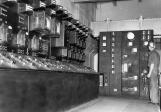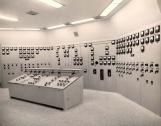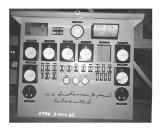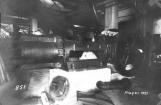15
The old boilers in Number 1 Steam Plant, everything was charts and guages that actually gave you pressures. It was a hands-on thing. You actually controlled this and controlled that with conrol knobs and stuff. You changed chars with ink pens. When they brought the computer in, it was like it was in a box. They showed you a picture of a boiler on a screen. And it seems like not such a hands-on feel anymore. It's hard to get used to. I think you lose a lot of practical knowledge - you must trust what it says on the computer.Service Engineer
Interview tapes
People of the White City
17
Electronically, if it tells you something you believe it, instead of on the old system, if you doubted it, you went out and would actually check a valve, check something to see if it was working. Now they really believe what it tells you is true and it's not necessarily true. It'll say a valve is open and it's actually closed. And if you have a power failure, the screen goes dead. In the old panels, those panels were still there, those charts were still there, that pressure gauge was there.Service Engineer
Interview tapes
People of the White City
19
Compiled from an interview with an electrical engineer.....another one of these keen guys, he called me up and said "there's something wrong in the big generator"--the biggest one we have down there, big water wheel generator. The water wheel's underneath, and a big shaft comes up and the generator's on top. He said, "Something's just not right" and he couldn't tell me what it was. So we went down, and I wasn't familiar enough, and I crawled around. It was coming from the generator, so we went in in the basement where the turbine is, and there was a trap door to get up inside the generator which is operating at a 13,000 volt level. And we crawled in under the coils in the generator to see if we could see anything. There was one bearing on the shaft right in the base of the generator. There was no bearing on top, just the bearing in the water wheel and a bearing in the generator. And what had happened, this bearing that was set in the cement, it was a big bearing about 3 feet in diameter by 2 feet in diameter on steel arms. Well these had broken loose in the cement, and we could see it moving. So the whole generator (was moving). And this huge rotor which was about 20 feet in diameter, weighing many many tonnes, was flipping around. And if it hits the stator?--it wasn't whipping big time because there's only about three quarters of an inch air gap between the two, but if it does hit, then it wipes out all the coils and destroys the machine. Well we saw this. We had to crawl out of the space keeping our heads down--it was 24 or 30 inches high in there--we crawled out the two of us, and deafening noise, and just pulled the switch, and that's it, the mill goes down, we shut the whole place down. There was a stink about that--you can't just go pull a switch without telling everybody, but they had a few weeks to think about that while the machine was rebuilt.
Taped interview for People of the White City
21
Excerpts from transcripts obtained for People of the White City"The highline was operated by a steam donkey up the top of the hill. It was operated from a cable. It was there in (19)62 - that was when I got my first three shifts in the shipping department dumping sulphur and that's what they used to pull up the hill off the sulphur ships. They would dump into the sulphur cars and then they'd push the cars up to the idler, which is hooked to a cable, and then they'd give signals by a wire that would sound a horn up the hill telling the operator to go. Then you'd go up he hill, you'd have to jump off and yank the wire for him to stop, and then you'd have to give him a couple to come back, and then I think it was three to cut it loose, and then you had to jump on this thing as it was still in motion, as it's going my you, and get back on it. Because it would come up and then they'd have to let it come back down on its own because it worked on gravity on the hill because there were flat spots that you'd have to pull it up, let it go, and then down again - it was running free."
"We had ships coming in with clay and sulphur, and there used to be an old B dock, and that's where they came in. And there was a scale there - you had to scale every car when they came by on there with a load of sulphur or clay, and then the highline (pulled them up)."
"Also, there was a clay shed up the other end of the mill - by the new mill."
"(19)67 was when they put the new sawmill in, I think that's when it was torn down."
Taped interview for People of the White City
22
Acid TowerCirca 1923
Powell River, British Columbia, Canada
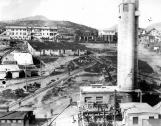 Credits:
Credits:P00516
Catalyst Paper, Powell River Division
23
Puff the Magic Dragon--that was Number 16 boiler. It used to have safety valves that would get going, I used to call them the old locomotive. Because the safety valves on there, when it blew steam it sounded just like a locomotive - it would chatter and bang, you could hear it all over Powell River.Number 16 boiler was a hog fired boiler. At times the furnace would become very unstable and it would puff and wheeze and belch smoke and sparks out onto the firing deck. It would often fill the Number 1 steam plant with smoke.
Taped interview for People of the White City
25
Galloping Gertie was an old compressor in the basement of the steam plant. It was steam operated and you had to get a big bar and crank the flywheel to get it to start turning.The air compressor pictured may have been the air compressor referred to as Galloping Gertie.
Taped interview for
People of The White City
27
An interview with a Power Generation department employeeThe board operator had the operation of all the power that came into the mill at that time and they distributed it from there, there was a distribution switch room behind the mezzanine floor wall. On the mezzanine floor where they had all these banks of switches, switch controls, they controlled all the generators throughout the mill, and the basic feeders feeding out of that.
There's one substation over at G3 - past the mill store, and that's where the power comes in from Lois River, and there's a high tension substation there, and there's transformer banks outside of that, and that delivered the power into the sawmill area, and 7-8 paper machines were fed out of that substation too.
There were three steam turbines on the system as well as the 1,2,3 & 4 generators powered out of Powell Lake. There were two [steam turbines] up in the steam plant, which fed on to the electrical bus up there, and there was one back pressure turbine down on number six paper machine. They were very small units, but they were used as reducing stations really, to break down high pressure steam to low pressure steam which they needed for the paper machines to dry out the paper. So they took a bit of power out of the steam before they put it into it, and that's why they were installed in those places.
The board operators had control of the generators when they were being synchronized - added to the power system. You take them off the line when you want to maintain them, and then you re-synchronize them. In this case, the water wheels, the wheel man would bring the water turbine up to speed, and it has to be right on, and then the board operator would synchronize it to the line. Everytime you bring a machine on it has to be synchronized.
Tape transcript
People of the White City
